When to start feeding baby food in jars
Feeding Your 4- to 7-Month-Old (for Parents)
Most babies this age are ready to try solid foods. Experts recommend starting solid foods when a baby is about 6 months old, depending on the baby's readiness and nutritional needs.
Be sure to check with your doctor before giving any solid foods.
Is My Baby Ready to Eat Solid Foods?
How can you tell if your baby is ready for solids? Here are a few hints:
- Does your baby swallow food or push it out of their mouth? Babies have a natural tongue-thrust reflex that pushes food back out. Wait until this reflex disappears (typically when babies are 4–6 months old).
- Can your baby support their own head? To eat solid food, an infant needs good head and neck control and should be able to sit up.
- Is your baby interested in food? Babies who stare, reach and grab, and open their mouths for food are ready to try solid foods.
If your doctor gives the go-ahead but your baby seems frustrated or uninterested in solid foods, try waiting a few days before trying again. Breast milk and formula will still meet nutritional needs as your baby learns to eat solid foods. But after 6 months, babies need the added nutrition — like iron and zinc — that solid foods provide.
Do not add cereal or other food to your baby's bottle because it can lead to too much weight gain.
Watch for signs that your child is hungry or full. Respond to these cues and let your child stop when full. A child who is full may suck with less enthusiasm, stop, or turn away from the breast or the bottle. With solid foods, they may turn away, refuse to open their mouth, or spit the food out.
How Should I Start Feeding My Baby Solid Foods?
When your baby is ready and the doctor says it’s OK to try solid foods, pick a time of day when your baby is not tired or cranky. You want your baby to be a little hungry, but not so hungry that they’re upset. So you might want to give your baby a little breast milk or formula first.
Have your baby sit supported in your lap or in a high chair with a safety strap.
Most babies' first food is iron-fortified infant single-grain cereal mixed with breast milk or formula. Place the spoon near your baby's lips, and let the baby smell and taste it. Don't be surprised if this first spoonful is rejected. Wait a minute and try again. Most food offered to your baby at this age will end up on the baby's chin, bib, or high-chair tray. Again, this is just an introduction.
When your little one gets the hang of eating cereal off a spoon, it may be time to try single-ingredient puréed meat, vegetables, or fruit. The order in which you give them doesn't matter, but go slow. Offer foods that are high in iron and zinc — such as meat, poultry, eggs, and beans — especially if your baby is breastfeeding. Try one food at a time and wait several days before trying something else new. This will let you identify any foods that your baby may be allergic to.
Which Foods Should I Avoid?
Foods that are more likely to cause allergies can be among the foods you introduce to your baby. These include peanuts, eggs, cow’s milk, seafood, nuts, wheat, and soy. Waiting to start these foods does not prevent food allergies. Talk to your doctor if you’re concerned about food allergies, especially if any close family members have allergies, food allergies, or allergy-related conditions, like eczema or asthma.
These include peanuts, eggs, cow’s milk, seafood, nuts, wheat, and soy. Waiting to start these foods does not prevent food allergies. Talk to your doctor if you’re concerned about food allergies, especially if any close family members have allergies, food allergies, or allergy-related conditions, like eczema or asthma.
Infants with severe eczema or egg allergies are more likely to have allergies to peanuts. Talk to your doctor about how and when to introduce these foods to your child.
Possible signs of food allergy or allergic reactions include:
- rash
- bloating or an increase in gassiness
- diarrhea
- vomiting
Get medical care right away if your baby has a more severe allergic reaction, like hives, drooling, wheezing, or trouble breathing.
If your child has any type of reaction to a food, don't offer that food again until you talk with your doctor.
Babies shouldn't have:
- foods with added sugars and no-calorie sweeteners
- high-sodium foods
- honey, until after the first birthday.
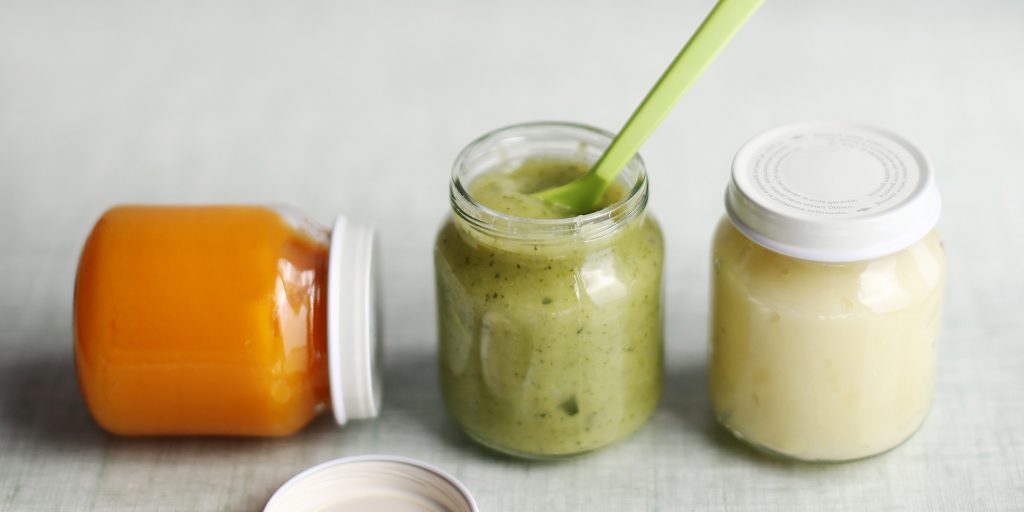 It can cause botulism in babies.
It can cause botulism in babies. - unpasteurized juice, milk, yogurt, or cheese
- regular cow's milk or soy beverages before 12 months instead of breast milk or formula. It’s OK to offer pasteurized yogurt and cheese.
- foods that may cause choking, such as hot dogs, raw carrots, grapes, popcorn, and nuts
Tips for Feeding Your Baby Solid Foods
With the hectic pace of family life, most parents try commercially prepared baby foods at first. They come in small, convenient containers, and manufacturers must meet strict safety and nutrition guidelines.
If you prepare your own baby foods at home, here are some things to keep in mind:
- Follow the rules for food safety, including washing your hands well and often.
- To preserve the nutrients in your baby's food, cook it in ways that keep the most vitamins and minerals. Try steaming or baking fruits and vegetables instead of boiling, which washes away the nutrients.
- Freeze portions that you aren't going to use right away.

- Whether you buy the baby food or make it yourself, texture and consistency are important. At first, babies should have finely puréed single-ingredient foods. (Just applesauce, for example, not apples and pears mixed together.)
- After your baby is eating individual foods, it's OK to offer a puréed mix of two foods. As babies get older, they will learn to eat a greater variety of tastes and textures.
- If you use prepared baby food in jars, spoon some of the food into a bowl to feed your baby. Do not feed your baby right from the jar — bacteria from the baby's mouth can contaminate the remaining food. If you refrigerate opened jars of baby food, it's best to throw away anything not eaten within a day or two.
- Around 6 months of age is a good time for your baby to try a cup. You might need to try a few cups to find one that works for your child. Use water at first to avoid messy clean-ups. Do not give juice to infants younger than 12 months.
Over the next few months, introduce a variety of foods from all the food groups. If your baby doesn't seem to like something, don’t give up. It can take 8 to 10 tries or more before babies learn to like new foods.
If your baby doesn't seem to like something, don’t give up. It can take 8 to 10 tries or more before babies learn to like new foods.
Sleep and Your 4- to 7-Month-Old (for Parents)
By this age, your baby should be well on the way toward having a regular sleep pattern. Some infants, particularly those who are breastfed, may still wake at night. But most no longer need a middle-of-the-night feeding.
How Long Will My Baby Sleep?
Most babies this age should sleep 12–16 hours a day, which includes a longer stretch at night and at least two naps during the day, says the National Sleep Foundation. The average amount of daytime sleep is now about 3–4 hours.
By 6 months, most babies are sleeping at night for 9 hours or longer, with brief awakenings.
How Should Babies Sleep?
The American of Academy of Pediatrics (AAP) recommends room-sharing without bed-sharing until the first birthday or for at least 6 months, when the risk of SIDs (sudden infant death syndrome) is highest.
Room-sharing is when you place your baby's crib, portable crib, play yard, or bassinet in your own bedroom instead of in a separate nursery. This keeps your baby nearby and helps with feeding, comforting, and monitoring your baby at night.
While room-sharing is safe, putting your baby to sleep in bed with you is not. Bed-sharing increases the risk of SIDS and other sleep-related deaths.
Follow these recommendations for a safe sleep environment for your little one:
- Always place your baby on their back to sleep, not on the stomach or side. The rate of SIDS has gone way down since the AAP began recommending this in 1992. When babies consistently roll over from front to back and back to front, it's fine for them to remain in the sleep position they choose.
- Use a firm, flat sleep surface. Cover the mattress with a sheet that fits snugly.
- Do not put anything else in the crib or bassinet. Keep plush toys, pillows, blankets, unfitted sheets, quilts, comforters, sheepskins, and bumper pads out of your baby's sleep area.

- To avoid overheating, dress your baby for the room temperature and don't overbundle. Don't cover your baby's head while they're sleeping. Watch for signs of overheating, such as sweating or feeling hot to the touch.
- Keep your baby away from smokers. Secondhand smoke increases the risk of SIDS.
- Offer a pacifier to your baby at sleep time, but don’t force it. If the pacifier falls out during sleep, you don’t have to replace it. If you're breastfeeding, wait until breastfeeding is firmly established.
- Watch out for other hazards, such as items with cords, ties, or ribbons that can wrap around a baby's neck, and objects with any kind of sharp edge or corner. Look around for things that your baby can touch from a seated or standing position in the crib. Hanging mobiles, wall hangings, pictures, draperies, and window blind cords could be harmful if they are within a baby's reach.
- Don’t let your baby fall asleep on a product that isn’t specifically designed for sleeping babies, such as a sitting device (like a car seat), a feeding pillow (like the Boppy pillow), or an infant lounger (like the Dock-a-Tot, Podster, and Bummzie).

- Don’t use products or devices that claim to lower the risk of SIDS, such as sleep positioners (like wedges or incliners) or monitors that can detect a baby’s heart rate and breathing pattern. No known products can actually do this.
- Don’t use weighted blankets, sleepers, or swaddles on or around your baby.
- Make sure that all sleep surfaces and products you use to help your baby sleep have been approved by the U.S. Consumer Product Safety Commission (CPSC) and meet federal safety standards.
Helping Your Baby Sleep
You may have started a bedtime routine that you're sticking to. If you haven't yet, now is a good time to start. Soothing activities that lead up to "night-night" time can help relax your baby. A warm bath followed by stories or singing will signal an end to the day, and these same activities can be used at bedtime for years to come.
You'll want your baby to fall asleep on their own. This may mean doing your nighttime routine and putting the baby into the crib while they're drowsy but still awake. If your baby cries, stay away for a few minutes. Your baby may settle down and go to sleep.
If your baby cries, stay away for a few minutes. Your baby may settle down and go to sleep.
If the crying continues, soothe your baby for a moment without picking your little one up. This may go on a few times until your baby figures out that the crying is not getting results. This can be tough for parents, since it's upsetting to hear your baby cry. If you know your baby is safe (and not hungry, wet, soiled, or feeling unwell), it's OK to give them time to settle down.
Why Does My Baby Wake at Night?
Even a baby who has been sleeping through the night will sometimes wake in the wee hours, just as adults do. Some babies may call out or cry in the middle of the night, then calm down when mom or dad enters the room. This is due to separation anxiety, a normal stage of development that happens during this time.
Give your baby a few fussy minutes before you respond. After seeing that everything is OK and reassuring your baby without taking your little one out of the crib, leave your baby alone to fall back to sleep.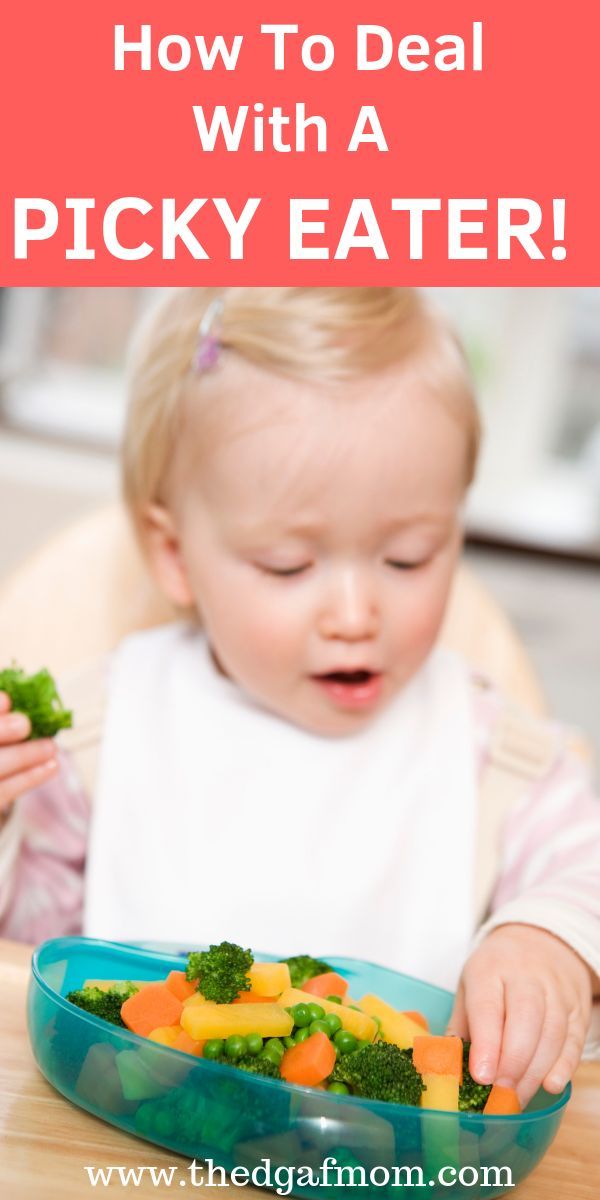
Remember: Cuddling, feeding, or talking when your baby wakes up may prompt your little one to wake regularly for this attention.
When Should I Call the Doctor?
Most infants at this age will have a regular sleep routine and are able to sleep through the night. But there is a wide range of normal. If you have any questions about your baby's sleep, talk with your doctor.
Baby food - from a jar or with your own hands? Pros and cons
Complementary foods are solid foods for young children in addition to dairy products that they have received for several months as their sole source of nutrition.
— Polina Alexandrovna, why is the introduction of complementary foods called a transitional stage in a child's nutrition?
— The beginning of acquaintance with complementary foods does not mean the transition to an adult table. The first or second complementary foods are important so that the child adapts and is psychologically ready to eat adult food, and his digestive organs are tuned to work properly. Therefore, complementary foods are considered a transitional stage from milk nutrition to nutrition at a common table.
Therefore, complementary foods are considered a transitional stage from milk nutrition to nutrition at a common table.
- Is the composition of canned zucchini or apple puree for babies different from the homemade version?
- Factory nutrition may vary depending on the raw materials that the manufacturer uses in a particular puree. Therefore, it is impossible to say that all such food is the same. For example, zucchini puree may contain rice flour so that its consistency is more correct in the opinion of the manufacturer. Mom decides what to put in, and in the same way she can add rice flour. An industrial puree that is suitable for a child and meets the requirements of parents may be identical in composition to homemade puree.
— There is a lot of speculation about baby food in jars. What are the most common parenting misconceptions?
- The most common myth is "canned mashed potatoes don't taste good and kids don't eat them well.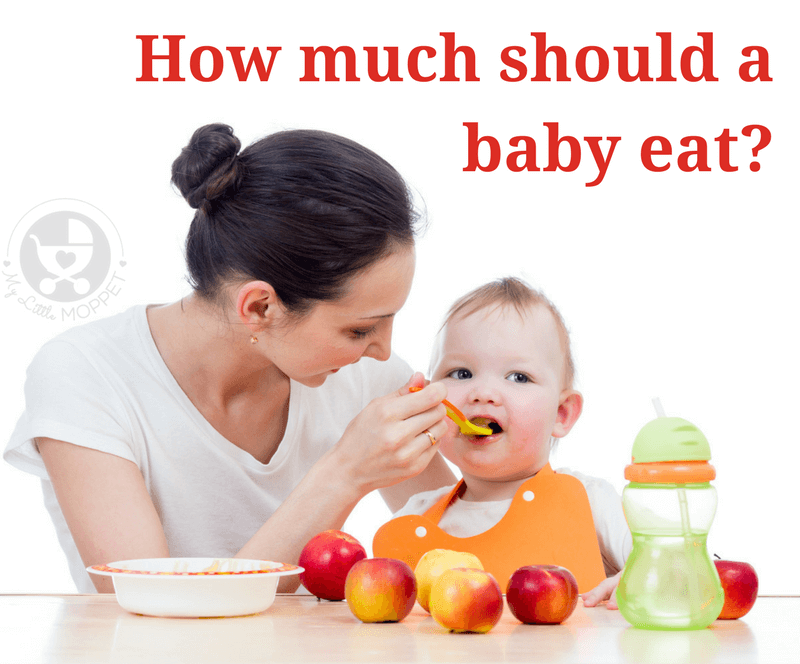 " In fact, most babies enjoy eating factory-made purees without experiencing any problems.
" In fact, most babies enjoy eating factory-made purees without experiencing any problems.
There are concerns that baby puree is “wrong” or does not meet nutritional requirements. The manufacturer is required by law to list all the ingredients of the product. For example, mashed potatoes may contain rice flour that is not always healthy, especially if vegetables are introduced to the child in order to avoid constipation. What kind of food is more useful for the baby, whether to buy just such a puree or look for another in composition - the parents decide together with the doctor. Therefore, it is wrong to equate all manufacturers and their products.
See also
- "10 myths about canned baby food"
- Puree is often said to contain preservatives.
— Modern technologies make it possible not to use preservatives in the production of baby food. That is why it is written on the jars that open food is not stored for more than a day even in the refrigerator. As long as puree does not come into contact with air, it does not spoil within the specified shelf life due to sterilization and vacuum packaging. After opening the jar and contact with air, the puree quickly deteriorates, which indicates the absence of preservatives in it.
As long as puree does not come into contact with air, it does not spoil within the specified shelf life due to sterilization and vacuum packaging. After opening the jar and contact with air, the puree quickly deteriorates, which indicates the absence of preservatives in it.
— Is it true that canned baby food is addictive, and then the child refuses natural products?
- There is no causal relationship here. When a child refuses a fresh apple, the problem is not the canned puree in his diet, but that he is not familiar with food in pieces. The child ate a homogeneous puree for a long time, and then they offer him a large piece of an apple - naturally, he will not cope with it right away. That is why, after the child gets used to a homogeneous puree, puree with soft small pieces is gradually introduced - so that there is no discomfort if the baby does not chew them. Gradually, the pieces become larger and denser. Over time, the child comes to eat a real whole apple or other hard fruit or vegetable.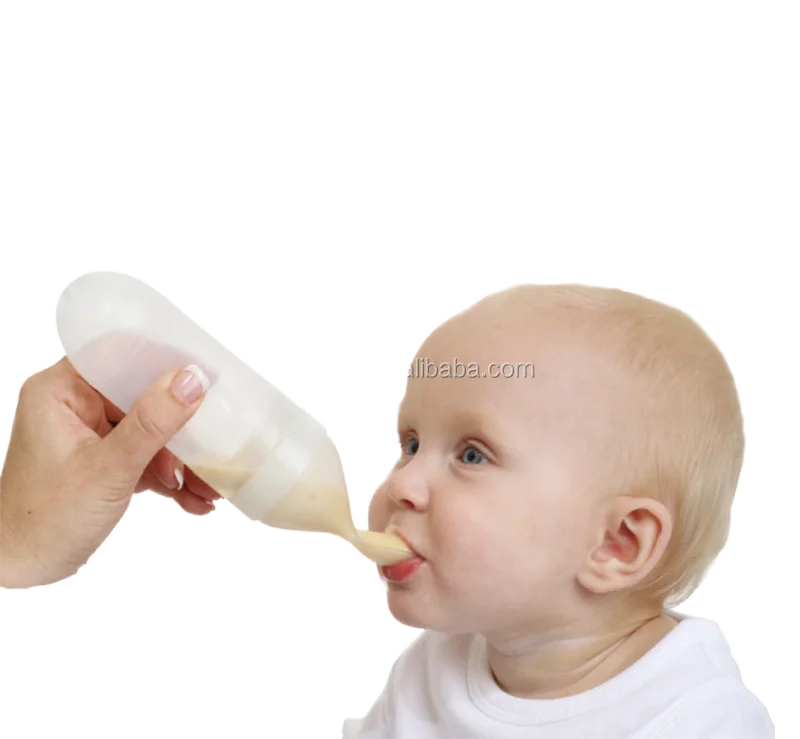
Baby food in a jar or homemade puree - which is right for a baby? Pros and cons of
— How long can I feed my baby bottled baby food?
- You can feed your baby as much as you like, there is no strict age limit. But baby needs to be introduced to the different textures and flavors of . The need for canned food usually disappears when the baby moves to a common table with a diet familiar to the whole family. During this period, puree from a jar, especially tasty and sweet fruit varieties, often becomes a safe treat for grown-up babies.
— In which cases canned baby puree is contraindicated?
- There are no diseases in which canned puree is contraindicated. But for some diseases, the presence of a particular product in baby food is undesirable. Factory puree is different in composition. Parents can choose purees without ingredients that are not suitable for the baby or should be limited in his diet, and continue to feed the canned product without problems.
— How to choose baby food in a jar that is healthy for a child?
- First of all, you need to read the full composition of the product on the back, because some ingredients are not indicated on the front label of the jar. It is important to pay attention to the expiration date of the food, the reputation of the manufacturer. All components of the puree must correspond to the age and condition of the child, his individual characteristics.
For example:
- the first puree must not contain rice flour;
- Strawberry puree should not be given to a four-month-old child;
- cereals are excluded from the diet of children with celiac disease (gluten intolerance);
- An older baby should be offered puree with chunks.
What mistakes do parents make when preparing mashed potatoes for feeding with their own hands
- Sometimes parents cook the wrong way - sometimes they overcook vegetables, and also make the puree too thin or thick. I hope that no one will fry food for their young children instead of boiling or steaming. Sometimes parents put spices and salt in baby puree, which is also not worth doing. The child should initially get acquainted with pure tastes, and extraneous additives are useless.
I hope that no one will fry food for their young children instead of boiling or steaming. Sometimes parents put spices and salt in baby puree, which is also not worth doing. The child should initially get acquainted with pure tastes, and extraneous additives are useless.
In addition, mothers need to be guided by foods that are appropriate for the age of the child, do not cause allergies and are not difficult for him, and also be guided by what the family eats. If parents give the baby something that they themselves do not eat, then when switching to an adult table, he may refuse the usual family food, he will have to cook it separately. This will be a big problem.
- The child refuses the food prepared by the mother and does not eat anything. What to do in such a situation?
— The same food or dish can be offered to the child during the week. Food selectivity in children often depends on taste sensations, but a child may refuse to eat for other reasons, for example, when he is not hungry or would like to play instead of dinner. If during the week the child does not perceive the product that the mother offers, perhaps he still does not like it. In this case, the same product can be given in the form of canned nutrition . Often, kids really refuse homemade puree, preferring the factory version. Again, mom can cook another product and give, for example, broccoli instead of zucchini, which the child will appreciate.
If during the week the child does not perceive the product that the mother offers, perhaps he still does not like it. In this case, the same product can be given in the form of canned nutrition . Often, kids really refuse homemade puree, preferring the factory version. Again, mom can cook another product and give, for example, broccoli instead of zucchini, which the child will appreciate.
Fruit baby puree MAMAKO ® contains 20% goat curd. This food option is convenient at the stage of introducing children not only to fruits, but also to dairy products. It is the little ones who eat sweet, tasty foods well during the first feeding period and even when they get older - for dessert.
- Are the recipes for complementary foods from 6 months and those for 10 months different?
- For toddlers, there are no recipes and complex dishes, because it is a simple food for discovering pure tastes without salt and spices, gradually getting used to the texture of the products.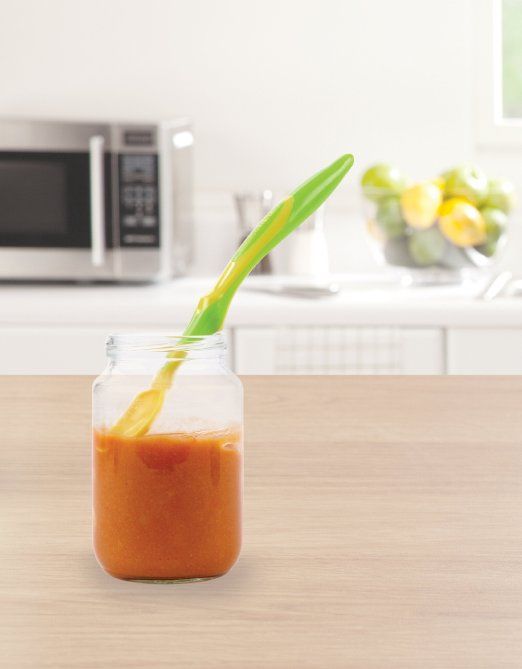 In the preparation of the first children's dishes, you can vary the combination of vegetables, focusing on the taste of the baby.
In the preparation of the first children's dishes, you can vary the combination of vegetables, focusing on the taste of the baby.
Recipes appear from the age of two or three with a full transition to the common table, when family preferences become more important. Of course, the baby needs to be introduced to products that are not consumed in the family, because there is a kindergarten and a school ahead. However, the basis of his diet should be food from the general household table . In addition, parents should be careful in cooking: do not overcook foods, do not add artificial ingredients, properly cool food so that homemade vegetable or fruit puree for the first feeding is healthy and safe for the baby.
- Is it possible to combine canned and homemade food and in what proportions?
— There are no strict rules: what is convenient for the family is chosen. For example, it is difficult to make meat puree at home, so sometimes parents add industrial meat supplements to homemade vegetable puree.
There is also no clear gradation in the percentage of different food options. In one plate, you can mix what you have prepared yourself with what you bought in the store. But at home it is not always possible to achieve the desired combinations and prepare, for example, a combined product that includes a variety of fruits and cottage cheese.
Choose a way of eating that is comfortable for your family. It is easier for someone to cook for their child on their own, for someone it is easier to buy ready-made mashed potatoes. Pediatricians often recommend mashed vegetables or fruits of industrial production, because when it is used for a child, the risk of undesirable consequences is much less.
* Breast milk is the best food for babies. WHO recommends exclusive breastfeeding for the first 6 months of a child's life and continued breastfeeding after complementary foods are introduced until the age of 2 years. Before introducing new products into the baby's diet, you should consult with a specialist. The material is for informational purposes and cannot replace the advice of a healthcare professional. For feeding children from birth.
The material is for informational purposes and cannot replace the advice of a healthcare professional. For feeding children from birth.
First complementary foods: canned food or homemade food
Komsomolskaya Pravda
Dom. FamilyMom and babyMom and baby: Education and developmentMom and baby: Nutrition
April 28, 2010 14:45
Pediatric gastroenterologist Alina Eremeeva gives advice [discussion]
When your child has grown up and is ready to try adult food, you have to make a decision - Will you prepare the first purees yourself or buy a ready-made jar in the store? From ready-made jars for all tastes, the shelves are bursting. Here are the usual potatoes - carrots, and spaghetti and gourmet meatballs, and cereals, and fruit biscuits, and all this is mixed in mashed potatoes. But how do you decide what to feed your child? And how do you choose good food?
Advantages of homemade food 1. You can see the products you cook with. 2. Homemade puree is fresh, just off the stove, and the vitamins in it are preserved to the maximum.3. No preservatives.4. You can mash vegetables, fruits, or meats to the consistency your baby needs.
2. Homemade puree is fresh, just off the stove, and the vitamins in it are preserved to the maximum.3. No preservatives.4. You can mash vegetables, fruits, or meats to the consistency your baby needs.
Disadvantages of homemade food 1. Now it is difficult to find organic vegetables and fruits, you can grow them in the country, but not everyone has land, and in winter you still have to buy.2. We cannot judge the quality of products purchased by us in a store or on the market. What conditions did they grow up in? What were cereals, vegetables and fruits fertilized with, what did animals eat? Cooking takes time, which a young mother always has to spare.4. When the baby is very hungry, it is not easy for him to wait until his mother prepares mashed potatoes.
HOME FEEDING RULES
If you prefer to cook your own baby food, try to follow a few important rules for preparing vegetable or fruit puree.
- You must be sure that fruits and vegetables have not been treated with various pesticides and other chemicals.
- Select the best fruits, without a single spot or flaw.
- Strictly comply with sanitary and hygienic standards when handling and preparing vegetables and fruits.
- It is better to wash, peel, chop fruits and vegetables immediately before preparing them and feeding the child.
- Vegetables and fruits should be placed in boiling water for boiling, but it is more useful to steam them whole.
- Puree vegetables and fruits thoroughly through a sieve, even twice or thrice at first, they can also be passed through a meat grinder or chopped in a blender to achieve a homogeneous structure. This is important for the very first samples of adult food.
- Ready puree can be kept in the refrigerator for no more than 2 hours.
- Add butter, milk, cottage cheese to a slightly cooled puree.
- Dried vegetables and fruits can be used in baby food from a very young age. Soups are prepared from dried vegetables, and compotes and additives to cereals and casseroles are prepared from fruits. Some dried fruits (apples, raisins, dates, prunes, dried apricots, figs) are high in minerals (potassium, iron, etc.). But dried fruits are poor in vitamins.
Some dried fruits (apples, raisins, dates, prunes, dried apricots, figs) are high in minerals (potassium, iron, etc.). But dried fruits are poor in vitamins.
- Freezing fruits and vegetables is the most perfect way to preserve their original nutritional value and also ensures their long-term storage. Frozen berries, fruits and vegetables are much more beneficial than dried and dried ones. Rapid freezing at low temperatures allows you to save not only the main nutrients, but also vitamins in the products. To minimize their losses during cooking, it is enough to wash the product with cold water and, without defrosting, lower it into boiling water. When using frozen berries in their natural form, they must be washed in cold water, and then thawed at room temperature in a sealed container, protected from light. If you will freeze food yourself, remember the timing. Root vegetables, all types of cabbage, green peas, asparagus, bell peppers, fruits and mushrooms can be stored for up to a year.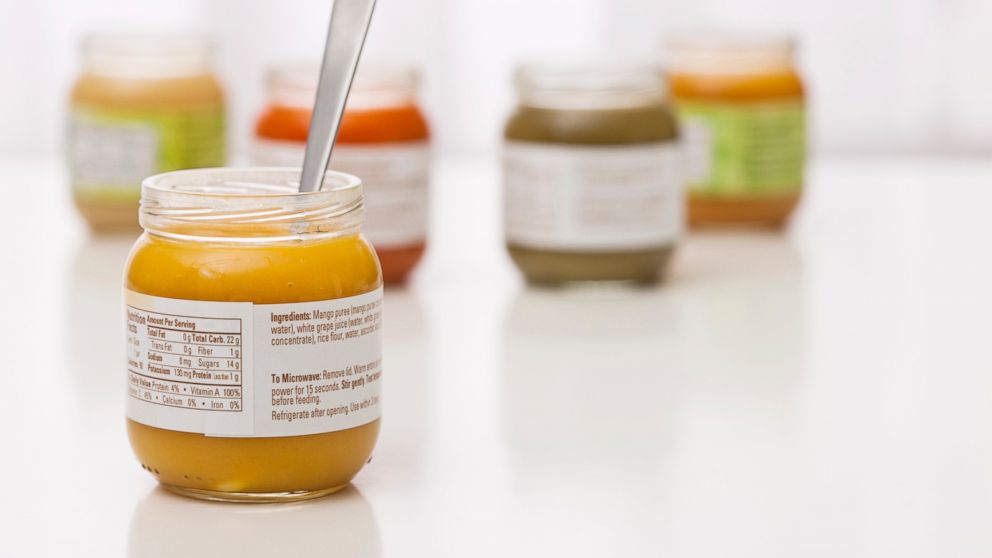 From fruits, pears are unsuitable for deep freezing, and from vegetables, green salad and cucumbers, because they contain too much water.
From fruits, pears are unsuitable for deep freezing, and from vegetables, green salad and cucumbers, because they contain too much water.
THE TRUTH ABOUT JARS
In today's difficult environmental conditions, special "canned" food helps a lot. Only now you need to choose jars only from proven and reliable manufacturers. You can feed your baby with baby food from the very beginning of the introduction of complementary foods (4-6 months) up to one and a half to two years with a gradual transition to a common table by three years. What are the advantages of industrial production nutrition, and what should you pay attention to?
Ingredient quality Good baby food is made from high-quality raw materials and meets all standards and hygiene requirements. Some manufacturers use environmentally friendly products and conduct up to 260 tests - from soil and air quality to the consistency of the contents of each jar. Modern technologies make it possible to preserve vitamins in products as much as possible, to process vegetables, fruits, cereals and meat without loss of useful properties.
When canned or simply processed into good baby food, it does not include hydrogenated or animal fats, common vegetable oils, sugar, and often salt. Baby food, which includes meat of animals and birds, is distinguished by the quality of meat ingredients, which contain up to 4 times more useful unsaturated fatty acids. For baby food, dietary meat of rabbit, turkey, chicken, as well as beef, veal, lamb is usually used, while the fillet is only the lean and most nutritious part. Such meat is a source of valuable protein and especially easily digestible iron.
For the little ones (from 4-6 months), in whose menu parents have already begun to introduce complementary foods, choose baby food with the BIO label on the package. This badge guarantees that food is made from organic products, and all stages of cultivation, packaging and transportation comply with strict organic farming and production standards.
Consistency
Baby needs mashed potatoes, small pieces are suitable for a baby with teeth. According to the degree of grinding, vegetable purees are divided into: - homogenized (for children from 4-5 months), - wiped (for children over 6 months).
According to the degree of grinding, vegetable purees are divided into: - homogenized (for children from 4-5 months), - wiped (for children over 6 months).
Meat purees are divided into: - homogenized (particle size up to 0.3 mm; intended for children from 6-7 months), - puree-like (particle size up to 1.5 mm; suitable for children from 7-8 months), - coarsely ground (particle size up to 3 mm; intended for children from 9-12 months).
IMPORTANT Look at the jar, read the composition on the package. Industrial baby food should not contain artificial food additives, dyes, preservatives, flavor enhancers, flavors. This is important because the digestive system of a child's body is highly permeable to nutrients. And as a percentage of body weight, children eat and drink much more than adults. Therefore, if the products contain harmful substances, then a greater amount of impurities accumulate in the child's body, interfering with normal metabolism and the development of the immune system.
Alina Eremeeva - pediatrician, gastroenterologist, associate professor of MMA named after. Sechenova, HiPP expert.
What do you think? Which is safer for a baby - canned food or homemade food? What are you buying for your kids?
Age category of the site 18+
Online edition (website) registered by Roskomnadzor, certificate El No. FS77-80505 dated March 15, 2021
I.O. EDITOR-IN-CHIEF - NOSOVA OLESIA VYACHESLAVOVNA.
I.O. chief editor of the site - Viktor Fedorovich Kansky
Messages and comments from site readers are posted without preliminary editing. The editors reserve the right to remove them from the site or edit them if the specified messages and comments are an abuse of freedom mass media or violation of other requirements of the law.
JSC Publishing House Komsomolskaya Pravda. TIN: 7714037217 PSRN: 1027739295781 127015, Moscow, Novodmitrovskaya d. 2B, Tel.











